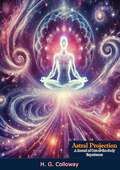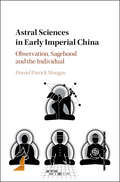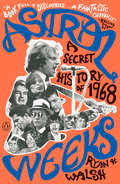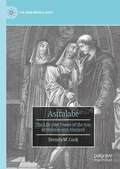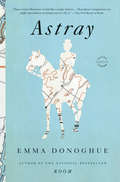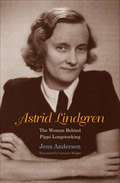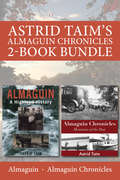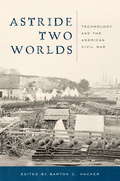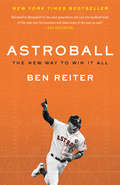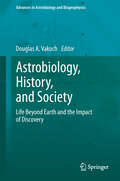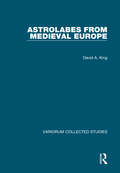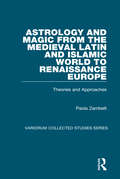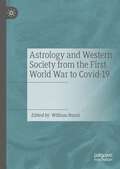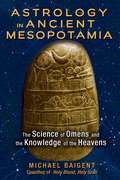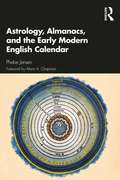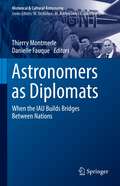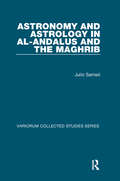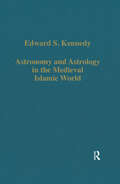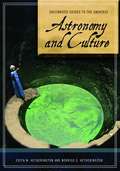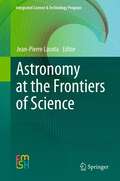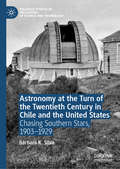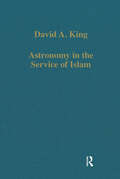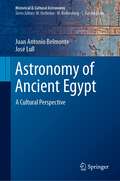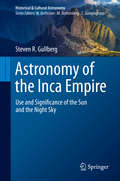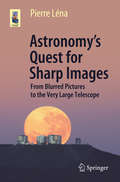- Table View
- List View
Astral Projection: A Record of Out-of-the-Body Experiences
by H. G. Colloway"Astral Projection: A Record of Out-of-the-Body Experiences" by H. G. Colloway is an enthralling and enlightening exploration of the fascinating phenomenon of astral projection. Colloway, a pioneering researcher in the field of metaphysics, presents a compelling account of his own out-of-body experiences, offering readers a unique and detailed perspective on this mysterious and often misunderstood practice.In this captivating work, Colloway shares his personal journey into the realm of astral projection, recounting his vivid and transformative experiences beyond the physical body. He provides an in-depth look at the techniques he employed, the challenges he faced, and the profound insights he gained during his excursions into the astral plane.Colloway's narrative is both accessible and profound, making complex concepts understandable for readers of all backgrounds. He delves into the historical and cultural contexts of astral projection, drawing connections between ancient practices and modern-day explorations. By blending personal anecdotes with scholarly research, Colloway offers a comprehensive guide to understanding and experiencing astral projection."Astral Projection: A Record of Out-of-the-Body Experiences" covers a wide range of topics, including methods for inducing astral travel, navigating the astral plane, and the potential benefits and risks associated with out-of-body experiences. Colloway also addresses common misconceptions and provides practical advice for those interested in exploring this intriguing phenomenon for themselves.This book is an invaluable resource for anyone curious about the nature of consciousness and the possibilities of human potential. Whether you are a seasoned practitioner or a novice eager to learn more, Colloway's insights and experiences offer a thought-provoking and inspiring journey into the world of astral projection.H. G. Colloway's "Astral Projection" is a must-read for metaphysical enthusiasts, spiritual seekers, and anyone interested in the extraordinary capacities of the human mind. It stands as a testament to the enduring mystery and wonder of out-of-body experiences, inviting readers to expand their horizons and explore the limitless potential of the astral realm.
Astral Sciences in Early Imperial China: Observation, Sagehood and the Individual
by Morgan Daniel PatrickChallenging monolithic modern narratives about 'Chinese science', Daniel Patrick Morgan examines the astral sciences in China c. 221 BCE-750 CE as a study in the disunities of scientific cultures and the narratives by which ancients and moderns alike have fought to instil them with a sense of unity. The book focuses on four unifying 'legends' recounted by contemporary subjects: the first two, redolent of antiquity, are the 'observing of signs' and 'granting of seasons' by ancient sage kings; and the other two, redolent of modernity, involve the pursuit of 'accuracy' and historical 'accumulation' to this end. Juxtaposing legend with the messy realities of practice, Morgan reveals how such narratives were told, imagined, and re-imagined in response to evolving tensions. He argues that, whether or not 'empiricism' and 'progress' are real, we must consider the real effects of such narratives as believed in and acted upon in the history of astronomy in China.
Astral Weeks: A Secret History of 1968
by Ryan H. WalshA mind-expanding dive into a lost chapter of 1968, featuring the famous and forgotten: Van Morrison, folkie-turned-cult-leader Mel Lyman, Timothy Leary, James Brown, and many more Van Morrison's Astral Weeks is an iconic rock album shrouded in legend, a masterpiece that has touched generations of listeners and influenced everyone from Bruce Springsteen to Martin Scorsese. In his first book, acclaimed musician and journalist Ryan H. Walsh unearths the album's fascinating backstory--along with the untold secrets of the time and place that birthed it: Boston 1968.On the 50th anniversary of that tumultuous year, Walsh's book follows a criss-crossing cast of musicians and visionaries, artists and hippie entrepreneurs, from a young Tufts English professor who walks into a job as a host for TV's wildest show (one episode required two sets, each tuned to a different channel) to the mystically inclined owner of radio station WBCN, who believed he was the reincarnation of a scientist from Atlantis. Most penetratingly powerful of all is Mel Lyman, the folk-music star who decided he was God, then controlled the lives of his many followers via acid, astrology, and an underground newspaper called Avatar.A mesmerizing group of boldface names pops to life in Astral Weeks: James Brown quells tensions the night after Martin Luther King, Jr. is assassinated; the real-life crimes of the Boston Strangler come to the movie screen via Tony Curtis; Howard Zinn testifies for Avatar in the courtroom. From life-changing concerts and chilling crimes, to acid experiments and film shoots, Astral Weeks is the secret, wild history of a unique time and place.One of LitHub's 15 Books You Should Read This March
Astralabe: The Life and Times of the Son of Heloise and Abelard (The New Middle Ages)
by Brenda M. CookTwo of the most notable figures from the Middle Ages–the volatile, brilliant Abelard and the equally brilliant Heloise–became the parents of their son Astralabe before Abelard’s infamous, brutal castration. The couple spent the rest of their lives as monastics, in each other’s orbits if not in shared presence, as they became movers in the glittering monastic world of the early twelfth-century France. What happened to their strangely named Astralabe? Astralabe: The Life and Times of the Son of Heloise and Abelard rescues the “lost son” from footnotes and fiction and attempts to tell instead the story of a real man living in Europe in the twelfth century. This book assembles the references to Astralabe, provides background in the history of France and Switzerland, uncovers Abelard’s relationships with his family, with the ruling house of Brittany and more, and most importantly draws together all that is known of Astralabe.
Astray
by Emma DonoghueThe fascinating characters that roam across the pages of Emma Donoghue's stories have all gone astray: they are emigrants, runaways, drifters, lovers old and new. They are gold miners and counterfeiters, attorneys and slaves. They cross other borders too: those of race, law, sex, and sanity. They travel for love or money, incognito or under duress. With rich historical detail, the celebrated author of Room takes us from puritan Massachusetts to revolutionary New Jersey, antebellum Louisiana to the Toronto highway, lighting up four centuries of wanderings that have profound echoes in the present. Astray offers us a surprising and moving history for restless times.
Astrid Lindgren: The Woman Behind Pippi Longstocking
by Jens Andersen Caroline WaightThe first English‑language biography of Astrid Lindgren provides a moving and revealing portrait of the beloved Scandinavian literary icon whose adventures of Pippi Longstocking have influenced generations of young readers all over the world. Lindgren’s sometimes turbulent life as an unwed teenage mother, outspoken advocate for the rights of women and children, and celebrated editor and author is chronicled in fascinating detail by Jens Andersen, one of Denmark’s most popular biographers. Based on extensive research and access to primary sources and letters, this highly readable account describes Lindgren’s battles with depression and her personal struggles through war, poverty, motherhood, and fame. Andersen examines the writer’s oeuvre as well to uncover the secrets to the books’ universal appeal and why they have resonated so strongly with young readers for more than seventy years.
Astrid Taim's Almaguin Chronicles 2-Book Bundle: Almaguin / Almaguin Chronicles
by Astrid TaimThe Almaguin Highlands, an extensive territory covering a 90 kilometre corridor from Huntsville, north to Callander, west to Dunchurch, and east to the Algonquin Park border, is a land rich with lakes, rivers, and a lively history. Once considered as a site for a First Nations Reserve in the early 1800s, Almaguin became a centre for lumbering and ultimately a year-round mecca for outdoor enthusiasts. This 2-book bundle is Astrid Taim's definitive guide to the region and its heritage. Almaguin: A Highland History offers a wide range of stories from the opening of the area by colonization roads to the first vessels on the Magnetawan River and the courage of the early pioneers. Included are community histories of the many towns, villages, and ghost towns of today; profiles of colourful personalities; as well as interesting and amusing tales of these rugged early times. Almaguin Chronicles explores the relationship between lumbering and settlement throughout the Parry Sound District — the last frontier of this part of Ontario. Throughout, rare archival photographs and excerpts from unpublished memoirs augment the text.
Astride Two Worlds
by Barton C. HackerBy the middle of the nineteenth century, industrialization and military-technological innovation were beginning to alter drastically the character and conditions of warfare as it had been conducted for centuries. Occurring in the midst of these far-reaching changes, the American Civil War can justly be labeled both the last great preindustrial war and the first major war of the industrial age. Industrial capacity attained new levels of military significance as transportation improved, but in this, as in many other respects, the Civil War was distinctly transitional. Smoothbore artillery still dominated the battlefield, horse-drawn wagons and pack mules still carried the main logistic burden, seamstresses still outnumbered sewing-machine operators. Astride Two Worlds addresses the various causes and consequences of technological change for the course and outcome of the American Civil War.
Astroball: The New Way to Win It All
by Ben ReiterWhen Sports Illustrated declared on the cover of a June 2014 issue that the Houston Astros would win the World Series in 2017, people thought Ben Reiter, the article’s author, was crazy. <P><P>The Astros were the worst baseball team in half a century, but they were more than just bad. They were an embarrassment, a club that didn’t even appear to be trying to win. The cover story, combined with the specificity of Reiter’s claim, met instant and nearly universal derision. <P><P>But three years later, the critics were proved improbably, astonishingly wrong. How had Reiter predicted it so accurately? And, more important, how had the Astros pulled off the impossible? <P><P>Astroball is the inside story of how a gang of outsiders went beyond the stats to find a new way to win—and not just in baseball. When new Astros general manager Jeff Luhnow and his top analyst, the former rocket scientist Sig Mejdal, arrived in Houston in 2011, they had already spent more than half a decade trying to understand how human instinct and expertise could be blended with hard numbers such as on-base percentage and strikeout rate to guide their decision-making. <P><P>In Houston, they had free rein to remake the club. No longer would scouts, with all their subjective, hard-to-quantify opinions, be forced into opposition with the stats guys. Instead, Luhnow and Sig wanted to correct for the biases inherent in human observation, and then roll their scouts’ critical thoughts into their process. The numbers had value—but so did the gut. <P><P>The strategy paid off brilliantly, and surprisingly quickly. It pointed the Astros toward key draft picks like Carlos Correa and Alex Bregman; offered a path for developing George Springer, José Altuve, and Dallas Keuchel; and showed them how veterans like Carlos Beltrán and Justin Verlander represented the last piece in the puzzle of fielding a championship team. <P><P>Sitting at the nexus of sports, business, and innovation—and written with years of access to the team’s stars and executives—Astroball is the story of the next wave of thinking in baseball and beyond, at once a remarkable underdog story and a fascinating look at the cutting edge of evaluating and optimizing human potential.
Astrobiology, History, and Society: Life Beyond Earth and the Impact of Discovery (Advances in Astrobiology and Biogeophysics)
by Douglas A. VakochThis book addresses important current and historical topics in astrobiology and the search for life beyond Earth, including the search for extraterrestrial intelligence (SETI). The first section covers the plurality of worlds debate from antiquity through the nineteenth century, while section two covers the extraterrestrial life debate from the twentieth century to the present. The final section examines the societal impact of discovering life beyond Earth, including both cultural and religious dimensions. Throughout the book, authors draw links between their own chapters and those of other contributors, emphasizing the interconnections between the various strands of the history and societal impact of the search for extraterrestrial life. The chapters are all written by internationally recognized experts and are carefully edited by Douglas Vakoch, professor of clinical psychology at the California Institute of Integral Studies and Director of Interstellar Message Composition at the SETI Institute. This interdisciplinary book will benefit everybody trying to understand the meaning of astrobiology and SETI for our human society.
Astrolabes from Medieval Europe (Variorum Collected Studies)
by David A. KingThis is the fourth set of studies in the Variorum series by David King, a leading authority on the history of astronomy in Islamic civilization and on medieval astronomical instruments, European as well as Islamic. The first of the eleven studies collected here deals with medieval instruments in general, as precious historical sources. The following papers focus on individual astrolabes from the European Middle Ages and early Renaissance that are of singular historical importance. Two look at the origins of the simple universal horary quadrant and the complicated universal horary dial (navicula). The collection concludes with a list of all known medieval European astrolabes, ordered chronologically by region. Three "landmark" astrolabes are discussed: (1) the earliest known European astrolabe from 10th-century Catalonia, that milieu in which the astrolabe first became known to Europeans; (2) an astrolabe from 14th-century Picardy bearing numerals written in monastic ciphers as well as a later dedication mentioning two friends of Erasmus; (3) the splendid astrolabe presented in 1462 by the German astronomer Regiomontanus to his patron Cardinal Bessarion, with its enigmatic angel and Latin dedication, here presented in the context of other astrolabes of similar design from 15th-century Vienna.
Astrology and Magic from the Medieval Latin and Islamic World to Renaissance Europe: Theories and Approaches (Variorum Collected Studies)
by Paola ZambelliAstrology and Magic from the Medieval Latin and Islamic World to Renaissance Europe brings together ten of Paola Zambelli's papers on the subject, four of which are published in English for the first time. The papers in Part I of this volume deal with theories: the ideas of astrology and magic held by Renaissance thinkers; astrologers' ideas on universal history and its cycles; i.e. catastrophes and rebirths, theories; and myths regarding the spontaneous generation of man himself. Part II focuses on the role of astrologers in Renaissance society. As political counsellors, courtiers, and academics, their ideas were diffused and appreciated in both popular and high culture. Part III looks at the Great Conjunction of 1524 and on the long and extended debate surrounding it, which would not have been possible prior to Gutenberg, since astrologers printed numberless booklets (full of religious and political innuendo) predicting the catastrophe - flood, as well as earthquake or fire - foreseen for February 1524 (which, in the event, proved to be a month of extraordinary mild weather). Part IV reprints some review-articles of twentieth century scholars whose writing has contributed to our understanding of the historical problems concerning magic and other connected debates.
Astrology and Western Society from the First World War to Covid-19
by William BurnsThis book gathers contributions on the topic of astrology in the West during the twentieth and twenty-first centuries, from 1914–2022. It is the first collection exclusively devoted to a period that has been mostly neglected by historians of astrology, who have mostly devoted themselves to the ancient, medieval and early modern periods. Uninterested in vindicating or debunking astrology, contributors consider its cultural impact, its relation to historical events, and the ways in which it has changed in the last century. The broad range of subjects on modern Europe and the US include the relation of astrology with indigenous thought, interwar Polish astrology, and the relation of American astrologers to COVID. A bibliography of studies of modern astrology on a global basis is also included. This collection is a thoughtful contribution to the history of astrology and the sociology of belief as well as carrying significant implications for twentieth and twenty-first century history broadly.
Astrology in Ancient Mesopotamia: The Science of Omens and the Knowledge of the Heavens
by Michael BaigentA detailed study of the earliest forms of astrology in Mesopotamia and their far-reaching hermetic influences from the Renaissance to the present day• Reveals the roots of modern astrology in the Babylonian science of omens, which was concerned not with individuals but with the state and king• Explores Mesopotamian mythology as it relates to the planets and to astrology• Traces the hermetic transmission of this knowledge over the centuries from Mesopotamia to Egypt to Renaissance ItalyAmong the many significant discoveries excavated from Assyrian king Ashurbanipal’s royal library in Nineveh were tablets documenting the development of Mesopotamian astrology, now recognized as the earliest astrological science.Drawing upon translations of the Nineveh library tablets as well as many other ancient sources, Michael Baigent reveals the roots of modern astrology in the Babylonian science of omens. He explains how astrology in the Babylonian and Assyrian empires was concerned not with individuals but with the king and the state. He shows that by the first dynasty of Babylon, around 1900 to 1600 BC, astrology had become a systematic discipline, the preserve of highly trained specialists intent upon interpreting omens from the movements of planets and stars. He explores Mesopotamian mythology as it relates to the planets and to astrology as well as to Mesopotamian religion, magic, and politics--for the mythology of Babylon and Assyria served the state and thus changed as the state changed. He shows how this ancient form of astrology uniquely represents both Sun and Moon as masculine entities and Saturn (Ninurta) as the principle of order imposed on chaos. He examines the connections between ancient astrology and the symbolism of Western religions, such as how the “Greek” or “Templar” cross may symbolize the Babylonian god Nabu, now known as Mercury.Tracing the hermetic transmission of this knowledge over the centuries from Mesopotamia to Egypt to Florence, Baigent reveals how the religious and magical aspects of early Babylonian cosmological speculation played a significant role in the Renaissance, influencing prominent figures such as Cosimo de Medici, Marsilio Ficino, and Botticelli.
Astrology, Almanacs, and the Early Modern English Calendar
by Phebe JensenAstrology, Almanacs, and the Early Modern English Calendar is a handbook designed to help modern readers unlock the vast cultural, religious, and scientific material contained in early modern calendars and almanacs. It outlines the basic cosmological, astrological, and medical theories that undergirded calendars, traces the medieval evolution of the calendar into its early modern format against the background of the English Reformation, and presents a history of the English almanac in the context of the rise of the printing industry in England. The book includes a primer on deciphering early modern printed almanacs, as well as an illustrated guide to the rich visual and verbal iconography of seasons, months, and days of the week, gathered from material culture, farming manuals, almanacs, and continental prints. As a practical guide to English calendars and the social, mathematical, and scientific practices that inform them, Astrology, Almanacs,and the Early Modern English Calendar is an indispensable tool for historians, cultural critics, and literary scholars working with the primary material of the period, especially those with interests in astrology, popular science, popular print, the book as material artifact, and the history of time-reckoning.
Astronomers as Diplomats: When the IAU Builds Bridges Between Nations (Historical & Cultural Astronomy)
by Thierry Montmerle Danielle FauqueThis book illuminates a few highly significant events in history in which astronomers have helped keep contacts between astronomers of different states in moments of international political tensions or even crises. The chapters, written by 20 international authors, focus on four periods where astronomers were particularly active in international relations:1. The WWI period, the epoch of the creation of the IAU, in the context of the simultaneous creation of other scientific unions. The book also singles out the important role of A.S. Eddington and his network “across forbidden borders”.2. The Cold war period and its consequences, when several countries were divided between opposite blocs. “The China crisis” is told here from different viewpoints by Chinese astronomers, both from the mainland and from Taiwan, in parallel with the evolution of astronomy in South and North Korea. Germany’s twisted path in its membership of the IAU, from its admission in 1951 to its reunification in 1991 is shown as another example.3. The book then highlights a third period, when radio astronomers, in particular, were very active in “building bridges” between East and West. It also tells the history of how the apparently innocuous issue of the “lunar nomenclature” became extremely sensitive. The part ends on two chapters on Russian robotic missions and lunar surface features as well on the Russian participation in the “International Virtual Observatory” project.4. The fourth part reports for the first time on the “hidden story” of the relations between the IAU and the United Nations after the “Moon race” when the United Nations decided to challenge the IAU’s authority on “extraterrestrial names”. The final chapter reviews how twenty years later UNESCO and the IAU had become strong partners in the difficult, but highly successful organization of the International Year of Astronomy (2002-2009), and of the “Astronomy and World Heritage” intitiative (2008).
Astronomy and Astrology in al-Andalus and the Maghrib
by Julio SamsóThis new volume of papers by Julio Samsó deals with the development of astronomy and astrology in al-Andalus and the Maghrib between the 10th and the 19th centuries. Opening with a survey of the social history of the exact sciences in al-Andalus, the book then looks at astronomical tables: the first stages of the introduction of al-Khwarizmi's and al-Battani's tables through the school of Maslama al-Majriti, the development of Ibn al-Zarqalluh/ Azarquiel's theories in Maghribi zijes (Ibn al-Banna' and Ibn Azzuz) and the abandonment of this tradition towards the end of the 14th century. From this period onwards new Eastern zijes (Muhyi al-Din al-Maghribi, Ibn al-Shatir, Ulugh Beg) are introduced in the Maghrib and, towards the beginning of the 17th century, a translation of Abraham Zacut and José Vizinho's Almanach Perpetuum (end of the 15th century) becomes well known in the whole Islamic world, from Morocco to the Yemen. As well as zijes themselves, the author also deals with theoretical astronomy (the use of an elliptical deferent for Mercury in Ibn al-Zarqalluh's equatorium and the criticisms of Ibn al-Haytham and Jabir b. Aflah on Ptolemy's determination of the parameters of the same planet), and with the use of zijes for the calculation of horoscopes, and an experimental astrological method for the correction of mean motion planetary tables (Ibn Azzuz).
Astronomy and Astrology in the Medieval Islamic World (Variorum Collected Studies)
by Edward S. KennedyThis collection of studies by Edward Kennedy looks first at questions of spherical astronomy, celestial mapping and planetary models, and then deals with astrological calculations. Throughout the author emphasises the importance of advances in mathematics for understanding the development of medieval Arabic sciences. This collection of studies based on previously unexploited manuscript sources in Arabic and Persian. They were written by authors from the 9th through the 15th centuries, whose locations reached from south China in the east through Central Asia, the Middle and Near East, and North Africa, to Spain in the west. The topics are predominately astronomical rather than astrological. The former include eclipse predictions, problems in spherical astronomy, non-ptolemaic planetary theory, and the achievements of Ulugh Beg and his observatory. Astrological subjects treated are the method of calculating the ascendant, and how to determine astrological houses and lots. An astrological history of the career of Genghis Khan is also described.
Astronomy and Culture
by Edith W. Hetherington Norriss S. HetheringtonE. Hetherington, a former second language teacher and attorney, has paired with N. Hetherington (director, Institute for the History of Astronomy) to explore the relationship between astronomy and culture throughout history in the face of contradictory attitudes from the scientific community. This book introduces the discipline of archaeoastronomy to students and scholars by reviewing ancient mythologies about the universe, revealing Babylonian concepts of astronomy, charting the development of calendars and documenting the Copernican and Newtonian Revolutions. The authors also discuss the precarious relationship between religion and astronomy such as the debate between creationism and evolution. Annotation ©2009 Book News, Inc., Portland, OR (booknews.com)
Astronomy at the Frontiers of Science (Integrated Science & Technology Program #1)
by Jean-Pierre LasotaAstronomy is by nature an interdisciplinary activity: it involves mathematics, physics, chemistry and biology. Astronomers use (and often develop) the latest technology, the fastest computers and the most refined software. In this book twenty-two leading scientists from nine countries talk about how astronomy interacts with these other sciences. They describe modern instruments used in astronomy and the relations between astronomy and technology, industry, politics and philosophy. They also discuss what it means to be an astronomer, the history of astronomy, and the place of astronomy in society today.
Astronomy at the Turn of the Twentieth Century in Chile and the United States: Chasing Southern Stars, 1903–1929 (Palgrave Studies in the History of Science and Technology)
by Bárbara K. SilvaThis Palgrave Pivot tells the transnational story of the astronomical observatory in the hills near Santiago, Chile, built in the early twentieth century through the efforts of astronomers from the Lick Observatory in California. Venturing abroad to learn from largely unmapped Southern skies and, hopefully, answer lingering questions about the structure of the galaxy, they planned a three-year research expedition—but ended up staying for more than twenty-five years. The history of the Mills Expedition offers a window onto the history of astronomy, the challenges of scientific collaboration across national lines, and the political and cultural contexts of early-twentieth-century Chile and the United States.
Astronomy in the Service of Islam (Variorum Collected Studies)
by David A. KingBased on a wide variety of previously unstudied sources, these articles explain how science was applied to three aspects of Islamic ritual in the Middle Ages: the regulation of the lunar calendar; the organisation of the times of the five daily prayers; and the determination of the sacred direction (qibla) towards the Kaaba in Mecca. Simple procedures of folk astronomy were used by the scholars of religious law who determined popular practice; more complicated mathematical methods were provided by the scientists - and this proved a powerful incentive for the development of scientific analysis and research. Some of these procedures were to have far-reaching consequences. For example, the astronomical alignment of the Kaaba - known to various medieval writers, but long forgotten - led to the adoption of similar alignments for the qibla, and the final articles show how these were calculated, whether from astronomical observation or geographical computation, and their impact on the orientation of religious and secular architecture across the Islamic world. C’est à partir d’une grande diversité de sources inexplorées que ces articles expliquent comment la science avait été appliquée a trois aspects du rituel islamique au Moyen Age: la régulation du calendrier lunaire; l’organisation des heures assignées aux cinq prières quotidiennes; et l’établissement de la direction sacrée (qibla) vers la Kaaba de la Mecque. Des procédés simples d’astronomie populaire étaient utilisés par les érudits en droit religieux qui décidaient de la pratique populaire; des méthodes mathématiques plus complexes étaient offertes par les hommes de science - ce qui, en effet, s’avèra être une motivation puissante dans le développement de l’analyse et de la recherche scientifique. Certains de ces procédés eurent des consequences d’une grande portée par la suite. L’alignement astronomique de la Kaaba - pour ne reprendre qu’un exemple connu
Astronomy of Ancient Egypt: A Cultural Perspective (Historical & Cultural Astronomy)
by Juan Antonio Belmonte José LullThis book is a comprehensive reference on ancient Egyptian astronomy, one of the most important topics in historical astronomy. Written by two recognized specialists—one an astronomer trained in Egyptology and the other an Egyptologist trained in astronomy—it synthesizes and analyses the international body of research surrounding this ancient culture.The chapters in this work address all major topics in the field, including Egyptian cosmogony and worldview, timekeeping devices and calendars, landscapes and skyscapes, astronomy-influenced architecture, chronology and more. Each chapter includes an introduction, an overview of the existing documentation on the subject, a critical discussion of ongoing debates and questions, and a presentation of state-of-the-art research.Straddling the line between Egyptology and astronomy, this multidisciplinary book will appeal to any scholar or specialist interested in studying ancient Egyptian astronomy.
Astronomy of the Inca Empire: Use and Significance of the Sun and the Night Sky (Historical & Cultural Astronomy)
by Steven R. GullbergAstronomy in the Inca Empire was a robust and fundamental practice. The subsequent Spanish conquest of the Andes region disrupted much of this indigenous culture and resulted in a significant loss of information about its rich history. Through modern archaeoastronomy, this book helps recover and interpret some of these elements of Inca civilization.Astronomy was intricately woven into the very fabric of Andean existence and daily life. Accordingly, the text takes a holistic approach to its research, considering first and foremost the cultural context of each astronomy-related site. The chapters necessarily start with a history of the Incas from the beginning of their empire through the completion of the conquest by Spain before diving into an astronomical and cultural analysis of many of the huacas found in the heart of the Inca Empire.Over 300 color images—original artwork and many photos captured during the author’s extensive field research in Machu Picchu, the Sacred Valley, Cusco, and elsewhere—are included throughout the book, adding visual insight to a rigorous examination of Inca astronomical sites and history.
Astronomy’s Quest for Sharp Images: From Blurred Pictures to the Very Large Telescope (Astronomers' Universe)
by Pierre LénaSince the 1960s, astrophysical discoveries have blossomed, due to the emergence of powerful and new observational tools. Among them, a fantastic improvement of the sharpness of astronomical images, obtained with ground based optical telescopes, has been the result of two revolutions: adaptive optics and optical interferometry. Written for a general audience, interwoven with fascinating details about the evolution of vision and optics, this book tells a personal story of these revolutions in observational astronomy, born two centuries ago and blossoming in the past fifty years. With the construction of the Very Large Telescope in Chile, Europe played a leading role where young scientists, joining creative astronomers and engineers, have developed a superb creativity. Today, incredibly sharp images of exoplanetary systems and black hole environments are obtained and reveal new questions about Earth-like objects or fundamental physics. The author has been one of the actors of this adventure. His first-hand testimony is opening the future to new horizons.
